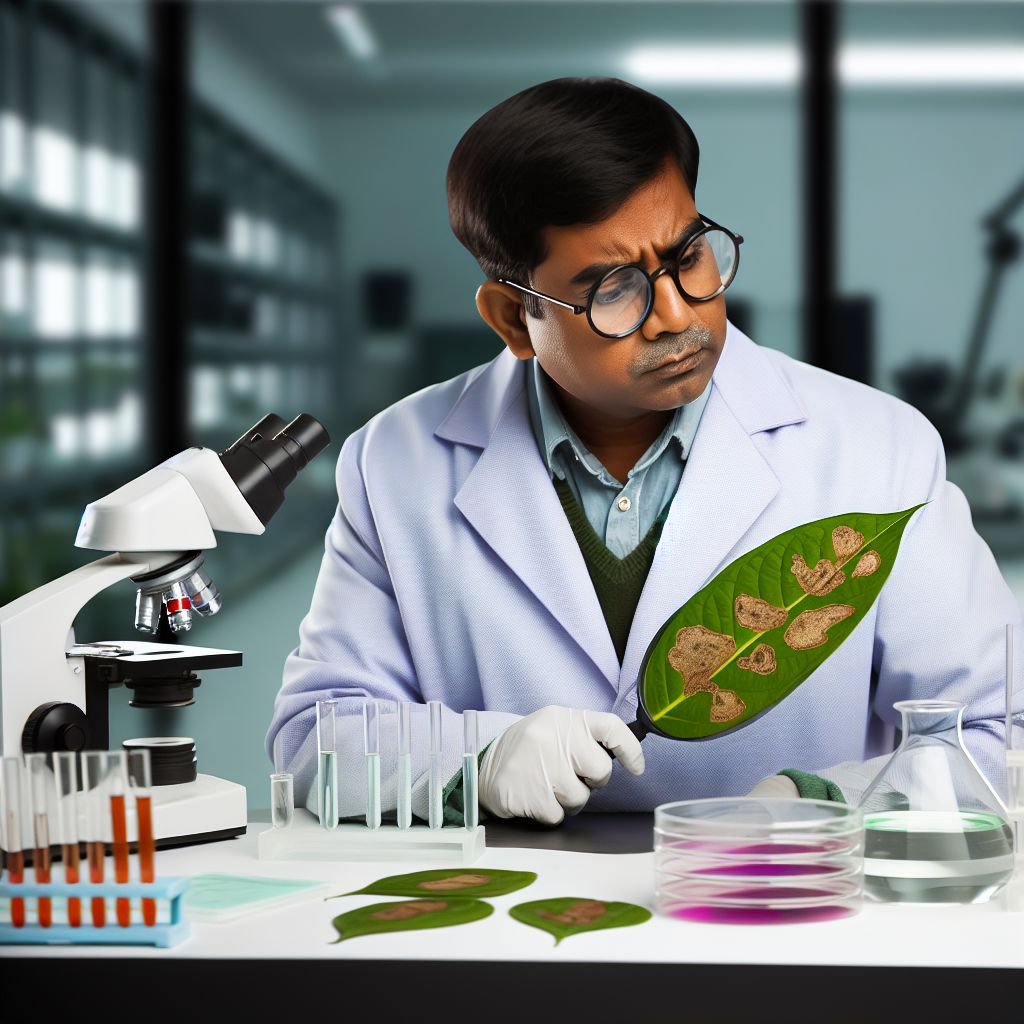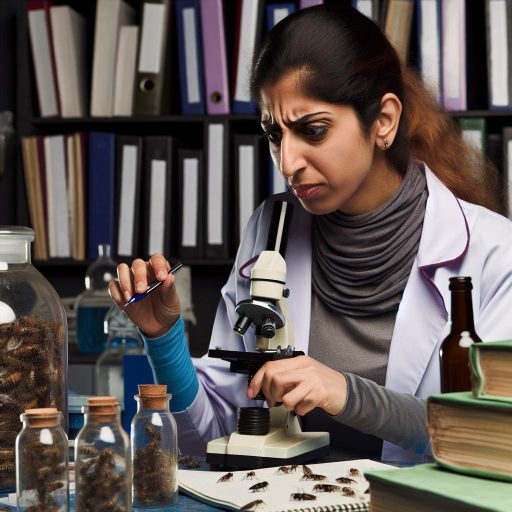Introduction:
Plant diseases can cause significant damage to crops.
This damage results in economic losses for farmers.
Plant pathologists play a crucial role in studying these diseases.
They develop strategies to manage them effectively.
Brief overview of plant diseases:
Plant diseases are caused by various pathogens such as fungi, bacteria, viruses, and nematodes.
These pathogens can infect plants through wounds, insects, or soil.
This infection leads to symptoms like wilting, discoloration, and stunted growth.
Importance of studying plant diseases:
Understanding plant diseases is essential for maintaining food security.
Sustainable agriculture benefits from this understanding.
Researchers can develop disease-resistant varieties.
They also devise effective management practices to protect crops.
Role of plant pathologists in identifying and managing plant diseases:
Plant pathologists utilize various techniques to identify pathogens.
These techniques include microscopy, molecular biology, and field surveys.
Research is conducted to develop disease control strategies.
These strategies may involve resistant crop varieties, cultural practices, and chemical treatments.
Common Fungal Plant Diseases
Fungal plant diseases are a common concern for plant pathologists as they can severely affect the health and growth of plants.
Some of the most common fungal plant diseases include powdery mildew, rust, and blight.
Examples of Common Fungal Plant Diseases
- Powdery Mildew: A fungal disease that appears as a white powdery substance on the leaves and stems of plants.
- Rust: A fungal disease characterized by orange or yellowish spots on plant leaves, often leading to defoliation.
- Blight: A fungal disease that causes wilting, browning, and death of plant tissue, usually starting at the tips of leaves.
Symptoms and Signs
Each fungal plant disease presents unique symptoms and signs that plant pathologists look for to diagnose the issue.
Symptoms of fungal diseases may include:
- Discoloration of leaves or stems.
- Wilting or drooping of plant parts.
- Growth of fuzzy or powdery spots on plant surfaces.
- Yellowing or browning of leaves.
Plant pathologists also look for signs of fungal diseases, such as:
Transform Your Career Today
Unlock a personalized career strategy that drives real results. Get tailored advice and a roadmap designed just for you.
Start Now- Fungal spores on plant surfaces.
- Webs or thread-like structures on plant parts.
- Rusty or orange-colored pustules on leaves.
Methods of Prevention and Control
Preventing and controlling fungal plant diseases is essential for maintaining the overall health of plants.
Plant pathologists recommend the following methods for effectively managing fungal diseases:
- Plant disease-resistant varieties.
- Proper spacing between plants for adequate airflow.
- Regularly inspect plants for signs of disease.
- Prune infected plant parts to prevent further spread.
- Avoid overhead watering to reduce moisture on plant surfaces.
- Apply fungicides as a preventative measure or treatment for fungal diseases.
- Clean garden tools and equipment to prevent the spread of fungal spores.
By implementing these preventative measures and control methods, plant pathologists can effectively manage common fungal plant diseases and help plants thrive in a healthy environment.
Bacterial plant diseases
Bacterial plant diseases are caused by various types of bacteria and can have devastating effects on plants.
Some common examples include bacterial blight, crown gall, and citrus canker.
Symptoms and signs
- Bacterial blight: Water-soaked lesions on leaves, stems, and fruit.
- Crown gall: Tumor-like growths on roots and stems.
- Citrus canker: Raised, corky lesions on leaves and fruit.
These symptoms and signs can vary depending on the specific bacterial pathogen and the type of plant being affected.
Management strategies
Effective management of bacterial plant diseases requires a combination of preventive measures and treatment options.
Here are some common strategies:
- Sanitation: Remove and destroy infected plant material to prevent the spread of bacteria.
- Resistant varieties: Planting resistant cultivars can help reduce the risk of disease.
- Pruning: Prune affected plant parts to improve air circulation and reduce bacterial growth.
- Copper-based fungicides: Copper sprays are commonly used to control bacterial diseases.
- Biological control: Beneficial microbes can be applied to suppress the growth of harmful bacteria.
It’s important to implement an integrated approach to managing bacterial plant diseases to effectively reduce their impact on crops and ornamental plants.
Find Out More: Trends in Veterinary Technician Employment
Viral Plant Diseases
Plant pathologists study viral plant diseases such as mosaic viruses, leaf curl viruses, and yellow dwarf viruses.
These diseases can have devastating effects on crops and ornamental plants.
They lead to reduced yield and aesthetic appeal.
Symptoms and Signs
- Mosaic viruses: Symptoms include mottled or streaked patterns on leaves, distorted growth, and stunted plants.
- Leaf curl viruses: Leaves exhibit upward curling, yellowing, and puckering, affecting overall plant health.
- Yellow dwarf viruses: Plants display yellowing of leaves, stunted growth, and reduced vigor.
How to Prevent the Spread of Viral Diseases
Prevention is crucial in managing viral plant diseases to protect your plants and crops.
Here are some steps you can take to prevent the spread of these diseases:
- Plant disease-resistant varieties: Choose plant varieties that are resistant to common viral diseases in your area.
- Practice good sanitation: Remove and destroy infected plant material to prevent the spread of viruses to healthy plants.
- Control insect vectors: Many viral diseases are transmitted by insects, so controlling insect populations can help reduce the spread of these diseases.
- Avoid mechanical transmission: Take care to sterilize pruning tools and equipment to prevent mechanical transmission of viruses between plants.
- Monitor plants regularly: Keep a close eye on your plants for any signs of viral diseases so you can take action promptly.
By implementing these preventive measures, you can minimize the impact of viral plant diseases and maintain the health of your garden or crops.
You Might Also Like: Irrigation Specialist: Job Description and Duties
Nematode Plant Diseases
Nematodes are microscopic roundworms that can attack a wide variety of plants. They can cause significant damage to crops. Plant pathologists study various nematode plant diseases to understand their impact. They also develop effective control methods.
Examples of Nematode Plant Diseases
- Root-knot nematodes
- Cyst nematodes
- Lesion nematodes
Each type of nematode plant disease has its own unique characteristics. They affect different parts of the plant.
Symptoms and Signs of Nematode Plant Diseases
Identifying nematode plant diseases can be challenging. Symptoms often mimic those caused by other factors. These factors include nutrient deficiencies or environmental stress. However, there are some common signs to look out for:
Transform Your Career Today
Unlock a personalized career strategy that drives real results. Get tailored advice and a roadmap designed just for you.
Start Now- Stunted growth
- Yellowing of leaves
- Wilting
- Root damage
- Galls or knots on roots
- Reduced yield
Plant pathologists use these symptoms and signs to diagnose nematode plant diseases. They recommend appropriate management strategies.
Control Methods and Management Practices
Controlling nematode plant diseases requires an integrated approach. This approach combines cultural, biological, and chemical methods. Here are some effective strategies used by plant pathologists:
- Use of resistant plant varieties
- Rotation of crops
- Soil solarization
- Nematode-suppressive crops
- Biocontrol agents
- Nematicides
Plant pathologists also focus on implementing sustainable practices. These practices minimize the use of chemical control methods. They promote long-term soil health.
Studying nematode plant diseases is essential for maintaining plant health. This study ensures sustainable crop production. Plant pathologists play a crucial role in identifying, managing, and preventing nematode-related issues. Their work contributes to global food security.
Gain More Insights: Best Practices for Livestock Artificial Insemination

Physiological Plant Disorders
Physiological plant disorders are non-infectious diseases that affect plants due to internal imbalances or environmental stressors.
These disorders can manifest in various ways, such as blossom end rot, leaf chlorosis, and wilting.
Examples of Physiological Plant Disorders
Blossom end rot is a common disorder seen in tomatoes and peppers.
The fruits develop dark, sunken lesions at the blossom end.
This is often caused by calcium deficiency or fluctuations in soil moisture levels.
Leaf chlorosis, on the other hand, is characterized by yellowing of plant leaves.
This occurs due to nutrient deficiencies, typically iron or nitrogen.
Such deficiencies can impact the plant’s ability to photosynthesize and produce energy.
Wilting is a clear sign of plant stress and is usually caused by inadequate water supply or excessive transpiration.
It can lead to irreversible damage if not addressed promptly.
Causes and Factors Contributing to Physiological Disorders
Physiological disorders can be triggered by a combination of factors, ranging from nutrient imbalances to environmental conditions.
Some common causes include:
- Inadequate soil nutrient levels
- Fluctuations in temperature and humidity
- Improper watering practices
- Excessive use of fertilizers
- Root damage or compaction
These factors can disrupt the plant’s normal physiological processes.
This disruption may lead to symptoms like poor growth, yellowing leaves, or fruit deformation.
Techniques for Addressing Physiological Plant Disorders
Managing physiological disorders requires a holistic approach that addresses both the underlying causes and the visible symptoms.
Transform Your Career Today
Unlock a personalized career strategy that drives real results. Get tailored advice and a roadmap designed just for you.
Start NowHere are some techniques for effectively dealing with these issues:
- Soil testing to identify nutrient deficiencies and pH imbalances
- Adjusting watering practices to maintain consistent moisture levels
- Improving soil structure through regular cultivation and aeration
- Implementing proper fertilization strategies based on plant needs
- Monitoring environmental conditions and providing appropriate protection
By implementing these strategies, plant pathologists can help plants overcome physiological disorders and thrive in their environment.
Early detection and prompt intervention are crucial in preventing long-term damage and ensuring optimal plant health.
Delve into the Subject: The Impact of Climate on Grape Cultivation
Importance of Early Detection and Diagnosis
Plant pathologists study common plant diseases to identify and address them promptly.
Early detection is crucial because it allows for effective treatment and prevention measures to be implemented before the disease spreads.
Impact of Early Detection on Plant Health and Yield
Early detection leads to healthier plants and higher yields.
By identifying diseases early, plant pathologists can prevent extensive damage, reduce crop losses, and ensure the overall health of plants.
Tools and Techniques Used by Plant Pathologists for Diagnosis
Plant pathologists use a variety of tools and techniques for disease diagnosis.
These may include microscopic examination, lab tests, DNA analysis, and field surveys to identify pathogens and determine the best course of action.
The Role of Research in Improving Detection and Diagnostic Methods
Research plays a crucial role in advancing detection and diagnostic methods for plant diseases.
Ongoing studies help plant pathologists develop new tools, technologies, and strategies to detect diseases more accurately and efficiently.
Managing Plant Diseases in Agriculture
After delving into the world of common plant diseases, it becomes clear that plant pathologists play a crucial role in managing these issues.
By studying the causes, symptoms, and treatments of plant diseases, they are able to provide valuable insights to farmers, gardeners, and agricultural professionals.
Recap of Common Plant Diseases Discussed
We have explored various plant diseases such as powdery mildew, leaf spot, root rot, and blight.
Each disease has its unique characteristics and requires specific management strategies to prevent their spread and minimize damage to plants.
Importance of Plant Pathologists in Managing Plant Diseases
Plant pathologists are essential in identifying, diagnosing, and treating plant diseases effectively.
Their expertise helps in developing preventive measures and control strategies to ensure plant health and productivity.
Without their knowledge and dedication, the agricultural industry would face significant challenges in combating plant diseases.
Encouragement for Readers to Learn More About Plant Diseases
As we have only scratched the surface of the vast world of plant diseases, we encourage readers to continue exploring this topic.
Transform Your Career Today
Unlock a personalized career strategy that drives real results. Get tailored advice and a roadmap designed just for you.
Start NowBy educating ourselves on common plant diseases and prevention strategies, we can contribute to the sustainability of our environment and food production.
Together, we can work towards a healthier and more resilient plant ecosystem.
Additional Resources
Agricultural and Food Scientists : Occupational Outlook Handbook …
Foreign Disease-Weed Science Research : USDA ARS
[E-Books for Sale]
The Big Book of 500 High-Paying Jobs in America: Unlock Your Earning Potential
$19.99 • 500 High-Paying Jobs • 330 pages
Explore 500 high-paying jobs in America and learn how to boost your career, earn more, and achieve success!
See All 500 High-Paying Jobs of this E-Book
1001 Professions Without a Degree: High-Paying American Jobs You Can Start Now
$19.99 • 1001 Professions Without a Degree • 174 pages
Discover 1001 high-paying jobs without a degree! Unlock career tips, skills, and success strategies for just $19.99!




